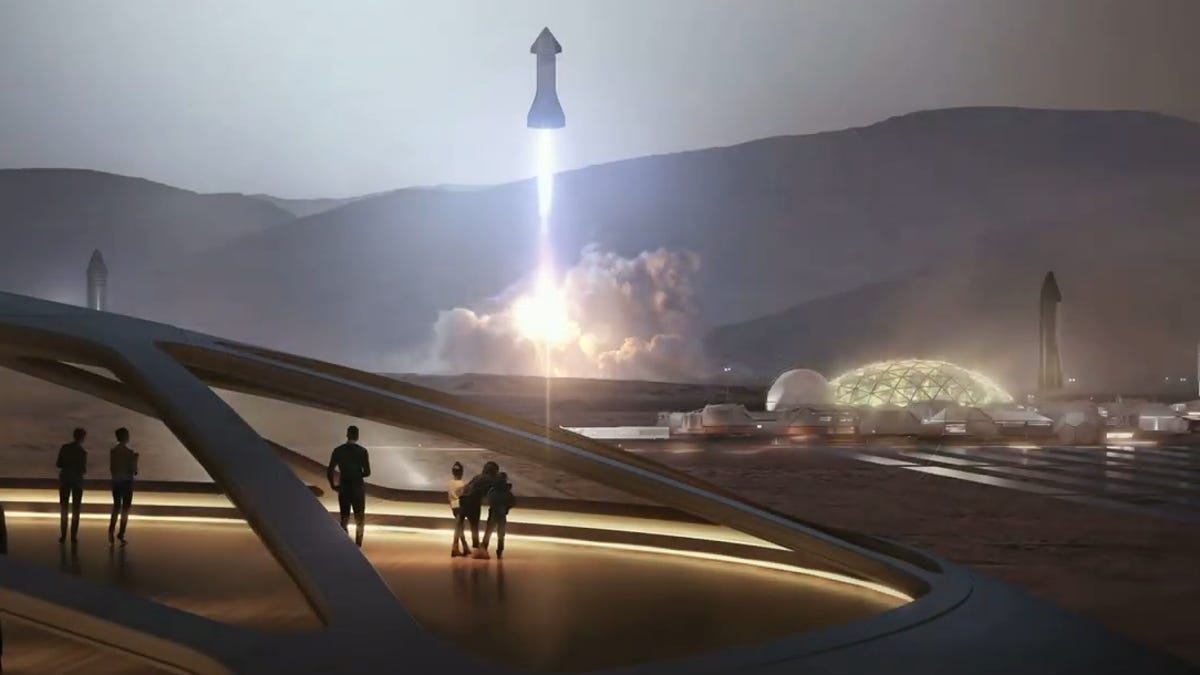Elon Musk says SpaceX Starship rocket could reach orbit within 6 months
"I think we should do our very best to become a multiplanet species and we should do it now."

Elon Musk's goal is to establish a city on Mars.
Elon Musk believes humans can and should become an interplanetary species. His new spaceship, he thinks, can help achieve that lofty goal. At the SpaceX facility in Boca Chica, Texas, on Saturday, Musk detailed what's next for the mighty would-be Mars rocket that could one day ferry humans to the Red Planet.
"This is the most inspiring thing I've ever seen," Musk said, standing in front of the Starship Mk1 prototype space vehicle.
This is the most epic thing I’ve ever seen in my life! #starship let’s do this @spacex @elonmusk pic.twitter.com/XGVSgPYeIs
— Everyday Astronaut (@Erdayastronaut) September 29, 2019
After walking through the construction history of SpaceX -- Sept. 28 marked 11 years since SpaceX first made it to orbit -- Musk, decked out in all black, went through some of the Starship specifics he's been tweeting about for months.
What's next for Starship?
The mission to Mars has always been at the forefront of SpaceX's endeavors. Three years ago, Musk outlined his ambitions to get humans to the Red Planet with a beastly two-stage, reusable rocket. The interplanetary craft detailed in that original proposal has now come to life. It's a real, tangible object you can see and touch. But the real challenge begins: getting it to fly.
A prototype vehicle, dubbed Starhopper, has completed two low-altitude flights, or "hops," kitted out with a single Raptor engine. The next milestone is to get the triple-engine prototype Mk1 off the ground, to an altitude of about 12 miles (20 kilometers). A second prototype, Mk2, is being built at the SpaceX facility in Florida. Musk said an Mk3 prototype would begin construction at Boca Chica "in about a month" and could be complete in three months.
"This is going to sound totally nuts, but we want to try and reach orbit in less than six months," he said.
Of course, deadlines have slipped before. Musk believes if the rate of production continues to proceed as quickly as it has already, the orbital vehicle could be a Mk4 or Mk5 prototype.
Details, details
During Saturday evening's hour-long, particularly windy press conference, Musk announced that the next test would take place in "about one to two months," before detailing how Starship would control its landing.
"This is quite a new approach to controlling a rocket," Musk said. "Much more akin to a skydiver than a plane."
Musk laughed as he showed the crowd in Boca Chica how the craft would control the fall, with his hands acting as the ship. Getting into the specifics a little more, Musk explained the importance of a steel heat shield that would only cost a fraction of a carbon fiber heat shield. "I'm in love with steel," Musk said.
The steel Starship heat shield that will protect the spacecraft as it comes back to Earth.
Super Heavy, the rocket that will boost Starship into orbit, didn't receive quite as much airtime. Musk said it would have about twice as much thrust as the most powerful rocket ever built, NASA's Saturn V, and feature up to 37 Raptor engines.
Musk also detailed plans for Starship "orbital refilling," which would allow fuel to be transferred between spacecraft in orbit. Musk said this process is easier than docking with the International Space Station -- something SpaceX has become quite good at. "This is one of the other critical pieces of the puzzle to establish a base on the moon or Mars," Musk noted.
Starship will use in-space propellant transfer to enable the delivery of over 100t of useful mass to the surface of the Moon or Mars pic.twitter.com/pzCUebidZg
— SpaceX (@SpaceX) September 29, 2019
Starship's ambitions aren't just the moon or Mars. Musk showed off promo art of a potential future for Starship that would have it head farther out into the solar system. Next destination? Saturn! (Well ... maybe not the next, next destination.)
Starship might one day take humans out to Saturn.
Musk concluded his press conference with a belief he's been championing ever since those initial Starship plans were detailed three years ago.
"I think we should do our very best to become a multiplanet species, and we should do it now."
Other SpaceX projects
SpaceX's next-gen rocket and mission to Mars are clearly a huge focus right now, but the company is also working with NASA on the Commercial Crew project, aiming to launch astronauts to the International Space Station from US soil. Ahead of Saturday's press event, NASA administrator Jim Bridenstine appeared to throw a little shade SpaceX's way by noting the Commercial Crew project is well behind schedule.
In a post-conference Q&A session, Musk provided a brief response.
"From a SpaceX resource standpoint, our resources are overwhelmingly on Falcon and Dragon," he said. "It was really quite a small percentage of SpaceX that did Starship."
Musk didn't detail any progress updates to SpaceX's Commercial Crew project but noted difficulty in the optimization process. A recent explosion during testing of the Dragon crew capsule further delayed SpaceX's ambitions of taking astronauts to the ISS before the end of the year. It now appears the first crewed launch will take place in 2020, with NASA stating future flight dates are under review.
Originally published Sept. 29.

